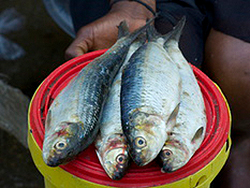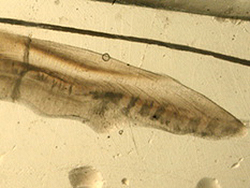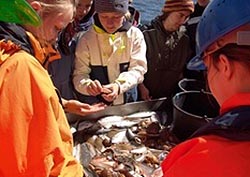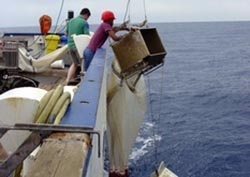Fisheries Biology should deliver the necessary knowledge on the biology, ecology and population dynamics of exploited (or potentially exploited) species to enable and ensure a sustainable fisheries and management of the resource. The Ecosystem Approach to Fisheries (EAF) requires the investigation of the biology of the species, the structure of the fish communities, processes and carrying capacity in the ecosystem and the interrelationships between compartments of the system.
A key requirement for understanding the status and development of a fish stock and its response to environmental changes is in the early life stages of the species. Eggs and larvae are the most vulnerable stages related to abiotic impacts or predators. Physiological constraints impact distribution and survival of the young stages and have a direct influence on year class strengths. Estuaries along tropical coasts play an important role as nursery areas for many species relevant to coastal fisheries.
Small scale fisheries are of outstanding importance for the protein supply of local populations along tropical coasts. However, in most cases the catches of the artisanal fishermen are poorly or not registered and do not appear in any official statistics. The biology and distribution of many species that are exploited are poorly studied or unknown, and stocks may be depleted before we even have the chance to learn their role in the ecosystem. This development leads to a decrease in biodiversity and may influence the stability of the coastal ecosystems.
The overall goal of the research of this working group is to investigate the impact of a variable and changing environment on fish communities, the growth and condition of fishes in coastal waters and their exploitability through fisheries:
Dynamics of estuarine tropical fish communities
The role of estuaries for the recruitment of coastal fish stocks is documented manifold. Estuaries are visited by different life stages of fishes for feeding, shelter, or spawning, respectively. Abundance and seasonality as well as growth and early life history patterns of coastal fishes is thus a central part of the working group’s activities. The analysis of otolith microstructure provides information on daily-based growth and allows the understanding of individual life histories of fish and thus a more detailed understanding of species-specific habitat use and related ecological processes.
We strive for an understanding of the conditions and challenges coastal fishes are faced to under changing climate conditions. A comparative approach is used to understand the impact of temperature, salinity and other factors by using the steep gradients in these parameters normally occurring in estuaries. A good example for such a system is the inverse estuary Sine Saloum in Senegal, where salinity is increasing upstream.
Connectivity
The spatial connectivity of fishes between nursery and offshore areas can be investigated by means of otolith chemistry to clarify the importance of coastal areas for shelf populations. Migration and transport processes are important in the life of fishes and their knowledge is crucial for a proper management of stocks. The question of connectivity of populations between different ecosystems is prominent. Aquatic animals use several ecosystems during their lifetime.
By means of isotope analysis in otoliths combined with aging methods on daily basis there is a potential to reconstruct the life history of single fishes and trace back there habitat over their life span. Coastal systems such as mangroves, seagrass meadows or coral reefs may serve as nurseries for species that normally dwell on the continental shelf or go even beyond the shelf edge and use the special environment of offshore seamounts for feeding. The understanding of these migratory pathways is of great importance for management aspects. Obviously, the location of MPAs, the definition of temporal and spatial resting zones has to consider the migratory behaviour of the target species.
Trophic position, growth and condition of key species
Changes in the hydrographic conditions influence the life performance of the species and lead to changes in the species communities of ecosystems. The role of a species in an ecosystem is partly defined by its position in the food web. Early stages build a link between small food organisms such as copepods and juvenile or adult fish. The survival capabilities of the early stages therefore are crucial for the development of a fish population. We investigate with traditional microscope and modern biochemical methods the trophic position of species in the system, their growth potential and condition to understand failure, success and variability in recruitment processes.
Physiological constraints and adaptations to environmental challenges such as hypoxia, increasing temperature and acidification
Temperature and oxygen have been shown to change significantly in the eastern parts of the tropical oceans. Fish species, especially early stages, are very sensitive to such changes, as their “environmental windows” (the range of a parameter, to which they are adapted) is small compared to larger fish. Tolerance against low oxygen concentrations varies from species to species. While some demersal fishes and crustaceans can cope with almost oxygen-free conditions for a short time, other species have very high thresholds and seem to be impacted by oxygen concentrations of medium ranges.
Within the project GENUS (Geochemistry and Ecology of the Namibian Upwelling System) we are investigating distribution, growth and physiological performance of early stages of key species of the system under low oxygen conditions to explain the large scale changes seen in distribution and biomass of these species.
Microplastics in coastal habitats and marine upwelling environments
In the context of the uptake and bioaccumulation of marine waste, micro- and mesoplastic (MP) materials and fragments have come into the focus of scientific and public attention: on the one hand due to their size ranges between > 1 μm and 5 mm, which allow interaction with plankton at the base of the marine food web (Cole et al., 2013), on the other hand due to their global presence and cumulative industrial application, leading to increasing amounts in freshwater and marine habitats (Ryan, 2015).Coastal ecosystems such as lagoons and estuaries as well as upwelling ecosystems are of essential biological, social and economic value. They also face severe exposure to microplastic particles as they receive major amounts of microplastic from land and function as sink or transition area of pollutants to the global oceans.
Though fish are among the group of organisms potentially affected by microplastics ingestion which are most intensively investigated both in the field and in laboratory, comprehensive studies on early life stages of fishes, which are the bottleneck in the development of fish populations, are lacking.
In the project MicroplastiX (Case studies of microplastic distribution in different ecosystems; 1 April 2020 until 31 March 2023), funded within the JPI-Oceans call 2018: Microplastics, different aspects of marine pollution with microplastics are addressed. The ZMT-subproject contributes in particular to the horizontal and vertical distribution of microplastics in coastal waters. The extensive sample collection, especially from the South Atlantic, also provides the opportunity to show a temporal development in the microplastic occurrence. In addition we will investigate the extent to which early developmental stages of fish are affected by the uptake of microplastics.
Capacity Development
We undertake a wide range of Capacity Development measures to strengthen the capability of tropical countries to implement a better and sustainable management of their living coastal resources. Besides courses incorporated into the curricula of the two master courses “International Studies in Aquatic Tropical Ecology” and “Marine Biology” at the University Bremen, we engage wherever possible in providing hands-on training for students, PhD-candidates and young researchers during research cruises, realize special training courses on different aspects of Fisheries Biology, and support institutes in partner countries to implement own study courses related to fisheries.








